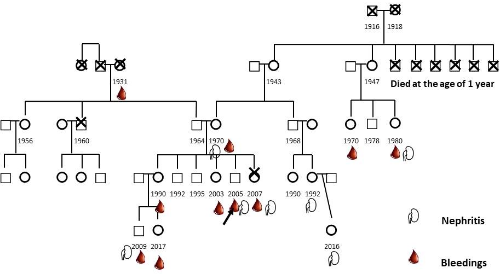
Contributions
Abstract: EP576
Type: E-Poster Presentation
Session title: Bleeding disorders (congenital and acquired)
Background
Congenital combined vitamin K-dependent clotting factors deficiency(VKCFD) is a very rare bleeding disorder, few cases have been described worldwide.
Aims
To describe clinical manifestations in 2 patients with bleeding disorder.
Methods
Retrospective medical chart review. Coagulation factor measurement was performed using standard kits and ACL TOP-700 coagulometer (IL, USA).
Results
1st Patient: 12yo boy who had unexplained bleeding episodes from the age of 1 year (easy bruising, epistaxis) was admitted an outpatient unit of our Centre because of excessive bleeding. By the time of admittance he had already had recurrent episodes of joint bleedings (elbow, ankle and shoulder joint 2 times), haematuria 5 times, bleeding after tooth extraction, easy bruising, epistaxis, bleeding from oral cavity (PBQ=19). that required plasma transfusions. At the initial laboratory assessment combined PT and APTT with normal fibrinogen and vWF:Rco had been revealed. Intestinal malabsorption and severe liver dysfunction were excluded, and clotting factors activity(CFA) were measured: FII 12%(79-131), FIX 30,4%(65-150), FV 85,4%(62-139), FVII 4,8%(50-129), FX 12,5%(77-131), FXI 93,4 % (N 65-150), FXII 83,8% (N 50-150), protein S 43.1% (70-130), protein C 41% (70-140). An increase in the CFA was detected 24 hours after of subcutaneous 10 mg Vitamin K1 injection, with a rapid loss of response after 48 hours.
2nd patient, his sister, who has been suffering from recurrent mild haematuria and menorrhagia (PBQ=5) and debuted at the age of 3 years with haematuria also had low CFA: FVII 11,4%, FII 13%, FIX 24%, FX 8%. No mutations in VKORC1 и GGCX genes using NGS were detected, so MLPA is planned. Other affected family members were suspected (Pic. 1).

Conclusion
The bleeding symptoms vary significantly even within the same family, despite comparable factor activity. No mutations in VKORC1 и GGCX genes were found, which doesn’t exclude VKCFD.
Keyword(s):
Abstract: EP576
Type: E-Poster Presentation
Session title: Bleeding disorders (congenital and acquired)
Background
Congenital combined vitamin K-dependent clotting factors deficiency(VKCFD) is a very rare bleeding disorder, few cases have been described worldwide.
Aims
To describe clinical manifestations in 2 patients with bleeding disorder.
Methods
Retrospective medical chart review. Coagulation factor measurement was performed using standard kits and ACL TOP-700 coagulometer (IL, USA).
Results
1st Patient: 12yo boy who had unexplained bleeding episodes from the age of 1 year (easy bruising, epistaxis) was admitted an outpatient unit of our Centre because of excessive bleeding. By the time of admittance he had already had recurrent episodes of joint bleedings (elbow, ankle and shoulder joint 2 times), haematuria 5 times, bleeding after tooth extraction, easy bruising, epistaxis, bleeding from oral cavity (PBQ=19). that required plasma transfusions. At the initial laboratory assessment combined PT and APTT with normal fibrinogen and vWF:Rco had been revealed. Intestinal malabsorption and severe liver dysfunction were excluded, and clotting factors activity(CFA) were measured: FII 12%(79-131), FIX 30,4%(65-150), FV 85,4%(62-139), FVII 4,8%(50-129), FX 12,5%(77-131), FXI 93,4 % (N 65-150), FXII 83,8% (N 50-150), protein S 43.1% (70-130), protein C 41% (70-140). An increase in the CFA was detected 24 hours after of subcutaneous 10 mg Vitamin K1 injection, with a rapid loss of response after 48 hours.
2nd patient, his sister, who has been suffering from recurrent mild haematuria and menorrhagia (PBQ=5) and debuted at the age of 3 years with haematuria also had low CFA: FVII 11,4%, FII 13%, FIX 24%, FX 8%. No mutations in VKORC1 и GGCX genes using NGS were detected, so MLPA is planned. Other affected family members were suspected (Pic. 1).

Conclusion
The bleeding symptoms vary significantly even within the same family, despite comparable factor activity. No mutations in VKORC1 и GGCX genes were found, which doesn’t exclude VKCFD.
Keyword(s):


